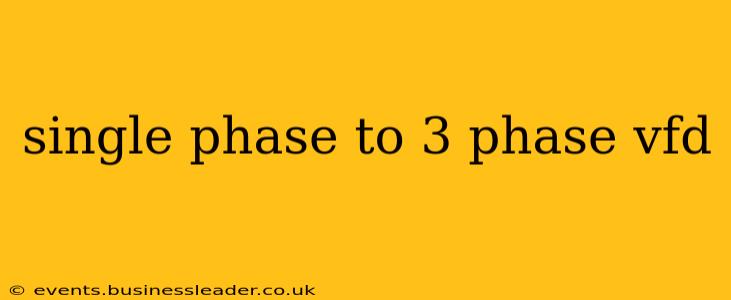Many industrial applications rely on three-phase motors for their robust performance and efficiency. However, not all locations have access to a three-phase power supply. This is where a single-phase to three-phase VFD (Variable Frequency Drive) becomes essential. This device cleverly converts single-phase AC power into three-phase AC power, enabling the operation of three-phase motors from a single-phase source. This guide will explore the functionality, applications, selection, and considerations of these vital pieces of equipment.
What is a Single-Phase to Three-Phase VFD?
A single-phase to three-phase VFD is a power electronic device that takes single-phase AC input voltage and converts it into balanced three-phase AC voltage at variable frequencies. This allows you to run a three-phase AC motor from a single-phase power source, something that wouldn't be possible directly. The conversion process typically involves rectifying the single-phase AC to DC, then using sophisticated switching techniques (like pulse width modulation or PWM) to generate the three-phase AC output.
How Does a Single-Phase to Three-Phase VFD Work?
The process can be broken down into these key steps:
-
Rectification: The single-phase AC input is first converted into DC using a rectifier circuit. This creates a stable DC voltage level.
-
DC Link: The DC voltage is then stored in a DC link capacitor, providing a reservoir of energy for the next stage.
-
Inverter: A three-phase inverter, using Insulated Gate Bipolar Transistors (IGBTs) or other power switching devices, switches the DC voltage to create a three-phase AC output. The frequency and voltage of this output are adjustable, allowing for speed control of the motor.
-
Pulse Width Modulation (PWM): PWM is a crucial technique used by the inverter. It rapidly switches the transistors on and off, effectively creating a variable AC waveform from the DC input. This allows precise control over the motor's speed and torque.
What are the Applications of Single-Phase to Three-Phase VFDs?
These versatile drives find use in a variety of applications where three-phase motors are preferred but only single-phase power is available:
-
Small Industrial Machines: Lathes, milling machines, and other small-scale industrial equipment often benefit from the higher power and efficiency of three-phase motors.
-
Agricultural Equipment: Pumps, conveyors, and other agricultural machinery can utilize single-phase to three-phase VFDs to improve performance and control.
-
HVAC Systems: Larger HVAC systems might incorporate three-phase motors for efficient operation, making single-phase to three-phase VFDs beneficial in areas with only single-phase power access.
-
Remote Locations: In locations without access to a three-phase supply, these VFDs are crucial for running three-phase equipment.
How to Select a Single-Phase to Three-Phase VFD?
Choosing the right VFD involves several key considerations:
-
Motor Power Rating: The VFD's power rating must be greater than or equal to the motor's power rating. Undersizing can lead to overheating and failure.
-
Voltage Compatibility: Ensure that the input voltage of the VFD matches the available single-phase supply voltage and that the output voltage matches the motor's requirements.
-
Frequency Range: Verify the VFD's frequency range suits the motor's operational speed requirements.
-
Features: Consider features like overload protection, braking functionality, and communication protocols (e.g., Modbus).
What are the Advantages of Using a Single-Phase to Three-Phase VFD?
Using a single-phase to three-phase VFD offers several advantages:
-
Efficiency: Three-phase motors are generally more efficient than single-phase motors of comparable power.
-
Soft Starting: VFDs provide soft starts, reducing mechanical stress on the motor and the connected equipment.
-
Speed Control: The ability to precisely control the motor's speed optimizes performance and efficiency for specific applications.
-
Extended Motor Life: Soft starts and precise speed control contribute to extending the motor's lifespan.
What are Some Common Problems with Single-Phase to Three-Phase VFDs?
While generally reliable, some potential problems include:
-
Overheating: Incorrect sizing or overloading can lead to overheating, which necessitates proper ventilation and sizing.
-
Harmonics: VFDs can introduce harmonics into the power supply, potentially affecting other equipment. Filters might be needed to mitigate this.
-
Cost: Single-phase to three-phase VFDs are generally more expensive than standard three-phase VFDs.
How Much Power Can a Single-Phase to Three-Phase VFD Handle?
The power handling capacity varies significantly depending on the model and manufacturer. You'll find VFDs ranging from relatively low power ratings (e.g., a few kilowatts) suitable for smaller applications to much larger units capable of handling tens or even hundreds of kilowatts. Always check the manufacturer's specifications to determine the appropriate capacity for your specific needs.
Can I Use a Single-Phase Motor with a Three-Phase VFD?
No, a standard three-phase VFD is designed to work specifically with three-phase motors. Attempting to use it with a single-phase motor will likely damage the VFD or the motor. You need a single-phase to three-phase VFD for this purpose.
This comprehensive guide provides a solid understanding of single-phase to three-phase VFDs, their applications, selection criteria, and associated considerations. Remember to always consult the manufacturer's instructions and specifications before installation and operation.
